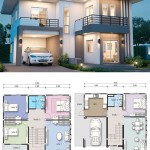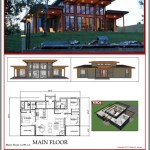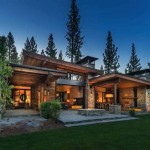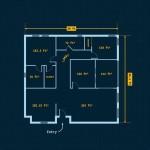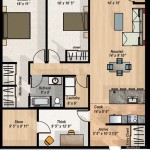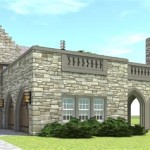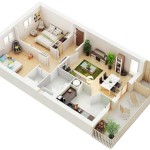Good 3 Bedroom House Plans With Pictures 2024
The demand for well-designed 3-bedroom house plans continues to rise in 2024, mirroring evolving lifestyles and the increasing need for functional and comfortable living spaces. These plans offer a balance between affordability, space optimization, and architectural appeal, making them a popular choice for families, young professionals, and empty nesters alike. This article explores key trends and exemplary designs in 3-bedroom house plans for 2024, offering insights into spatial layout, stylistic considerations, and features that define contemporary living.
A defining feature of modern 3-bedroom house plans is the emphasis on open-concept living. This design approach typically combines the kitchen, dining area, and living room into one unified space, fostering a sense of connectivity and maximizing natural light. This layout is particularly well-suited for social interaction and entertaining, while also creating the illusion of greater spaciousness. The strategic placement of furniture and architectural elements, such as islands and half-walls, can subtly delineate different zones within the open area without compromising the overall flow.
Another prevalent trend is the integration of indoor and outdoor living spaces. Patios, decks, and courtyards are increasingly seen as extensions of the interior, providing opportunities for al fresco dining, relaxation, and recreation. Large sliding glass doors or bi-fold doors seamlessly connect the interior with the exterior, blurring the boundaries between the two and allowing for natural ventilation and ample sunlight. This connection to the outdoors contributes to a sense of well-being and enhances the overall living experience.
Key Point 1: Optimized Spatial Layout and Functionality
The efficiency of spatial layout is paramount in 3-bedroom house plans. Every square foot should be utilized effectively to cater to the needs of the occupants. This involves careful consideration of room sizes, traffic flow, and storage solutions. A well-designed plan will minimize wasted space and prioritize functionality, creating a comfortable and practical living environment.
One common approach to optimizing space is the use of multi-functional rooms. For example, a guest bedroom can double as a home office or a hobby room. Similarly, a breakfast nook can serve as a workspace or a reading area. Built-in storage solutions, such as bookshelves, cabinets, and window seats with storage compartments, are also essential for maximizing space and minimizing clutter.
The location of the bedrooms is also a crucial factor in spatial layout. In many plans, the master bedroom is situated at one end of the house, providing privacy and separation from the other bedrooms. The remaining bedrooms are typically grouped together, often with a shared bathroom. This arrangement is particularly suitable for families with children, as it allows for easy supervision and interaction. However, some plans may opt for a split-bedroom layout, where the bedrooms are located on opposite sides of the house, offering greater privacy for all occupants.
The design of the kitchen is another area where functionality is paramount. Modern kitchens often feature spacious countertops, ample storage space, and well-placed appliances. Islands are a popular addition, providing extra workspace and seating. The layout of the kitchen should be efficient and ergonomic, allowing for easy movement and access to essential items. The inclusion of a pantry or walk-in pantry is also a desirable feature, providing additional storage for food and kitchen supplies.
Furthermore, the inclusion of a dedicated laundry room or mudroom is becoming increasingly common. These spaces provide a convenient area for washing and drying clothes, as well as for storing shoes, coats, and other outdoor gear. A well-designed laundry room or mudroom can help to keep the rest of the house clean and organized.
Accessibility should also be considered in the spatial layout of a 3-bedroom house. Wide doorways, level thresholds, and grab bars in the bathrooms can make the house more accessible for people with disabilities or mobility issues. Universal design principles, which aim to create spaces that are usable by everyone, should be incorporated into the design process to ensure that the house is comfortable and accessible for all occupants.
Consider a 3 bedroom 2 bath house plan with a total area of 1600 square feet. The master bedroom suite, located at the rear of the house, includes a walk-in closet and private bathroom with dual vanities. The two additional bedrooms are situated at the front of the house and share a bathroom. The open-concept living area features a large kitchen island with seating, a dining area with access to a patio, and a comfortable living room with a fireplace. A separate laundry room and mudroom are located off the garage entrance. This plan exemplifies efficient spatial layout and functionality, providing a comfortable and practical living environment for a family.
(Imagine an image showing a floor plan of the above mentioned house plan)
Key Point 2: Stylistic Considerations and Architectural Details
The aesthetic appeal of a 3-bedroom house plan is just as important as its functionality. The style of the house should reflect the tastes and preferences of the occupants, while also complementing the surrounding environment. A wide range of architectural styles are available, each with its own unique characteristics and features. These styles can be adapted and customized to create a home that is both beautiful and functional.
One popular style is the modern farmhouse, which combines traditional farmhouse elements with contemporary design features. Modern farmhouse plans often feature gabled roofs, board-and-batten siding, and large windows. The interior typically includes open-concept living areas, exposed beams, and shiplap walls. This style offers a warm and inviting atmosphere, while also being stylish and up-to-date.
Another popular style is the contemporary style, which emphasizes clean lines, minimalist design, and large windows. Contemporary plans often feature flat roofs, asymmetrical shapes, and a mix of materials, such as glass, steel, and concrete. The interior typically includes open-concept living areas, high ceilings, and abundant natural light. This style is well-suited for urban environments and those who appreciate a sleek and modern aesthetic.
Traditional styles, such as Craftsman, Colonial, and Cape Cod, also remain popular choices. Craftsman plans are characterized by their handcrafted details, such as exposed rafters, wide porches, and built-in cabinetry. Colonial plans are known for their symmetrical facades, formal living spaces, and traditional details. Cape Cod plans feature a simple rectangular shape, gabled roof, and dormer windows. These styles offer a classic and timeless aesthetic, while also providing a comfortable and functional living environment.
The choice of materials can also have a significant impact on the overall style of the house. Natural materials, such as wood, stone, and brick, can add warmth and texture to the exterior. Modern materials, such as glass, steel, and concrete, can create a sleek and contemporary look. The use of sustainable and eco-friendly materials is also becoming increasingly popular, reflecting a growing awareness of environmental concerns.
Architectural details, such as windows, doors, and trim, can also contribute to the overall style of the house. Large windows can maximize natural light and provide views of the surrounding landscape. Decorative doors and trim can add character and charm to the exterior. The use of accent colors can also enhance the architectural details and create a more visually appealing facade.
Consider a 3-bedroom house plan in the modern farmhouse style. The exterior features board-and-batten siding, a gabled roof, and a large front porch. The interior includes an open-concept living area with exposed beams and shiplap walls. The kitchen features a large island with seating and stainless steel appliances. The master bedroom suite includes a walk-in closet and private bathroom with a soaking tub. This plan exemplifies the stylistic considerations and architectural details that define the modern farmhouse style, creating a warm, inviting, and stylish home.
(Imagine an image showing a 3D rendering of the above mentioned house plan with modern farmhouse style features.)
Key Point 3: Smart Home Integration and Energy Efficiency
The incorporation of smart home technology and energy-efficient features is becoming increasingly prevalent in 3-bedroom house plans. These features enhance the comfort, convenience, and sustainability of the home, while also reducing energy consumption and lowering utility bills. Smart home integration encompasses a wide range of technologies, including automated lighting, climate control, security systems, and entertainment systems. Energy-efficient features include high-performance windows, insulation, and HVAC systems.
Smart lighting systems allow for automated control of the lights, adjusting brightness and color temperature based on time of day or occupancy. This can help to save energy and create a more comfortable living environment. Smart thermostats allow for remote control of the heating and cooling system, optimizing energy usage and maintaining a consistent temperature throughout the house. Smart security systems provide enhanced protection against intruders, with features such as motion sensors, door and window alarms, and surveillance cameras.
Energy-efficient windows and doors are essential for reducing heat loss in the winter and heat gain in the summer. Double-paned or triple-paned windows with low-E coatings can significantly improve energy efficiency. Proper insulation in the walls, roof, and floors is also crucial for maintaining a comfortable temperature and reducing energy consumption. High-efficiency HVAC systems, such as heat pumps and geothermal systems, can further reduce energy bills and improve indoor air quality.
Solar panels are another increasingly popular option for reducing energy consumption and generating renewable energy. Solar panels can be installed on the roof of the house to convert sunlight into electricity. The electricity generated by the solar panels can be used to power the house or sent back to the grid, earning credits on the utility bill. Solar panels can significantly reduce the carbon footprint of the house and contribute to a more sustainable lifestyle.
Water conservation is also an important aspect of energy efficiency. Low-flow toilets, showerheads, and faucets can significantly reduce water consumption. Rainwater harvesting systems can be used to collect rainwater for irrigation and other non-potable uses. Xeriscaping, which involves using drought-tolerant plants and landscaping techniques, can also reduce water consumption and create a more sustainable landscape.
The integration of smart home technology and energy-efficient features should be considered early in the design process. This allows for the optimal placement of wiring, plumbing, and other infrastructure. A well-designed smart home and energy-efficient home can provide a comfortable, convenient, and sustainable living environment while also reducing energy consumption and lowering utility bills.
Consider a 3-bedroom house plan with smart home integration and energy-efficient features. The house is equipped with smart lighting, a smart thermostat, and a smart security system. Energy-efficient windows and doors are installed throughout the house. The walls, roof, and floors are properly insulated. Solar panels are installed on the roof to generate electricity. Low-flow toilets, showerheads, and faucets are used to conserve water. This plan exemplifies the integration of smart home technology and energy-efficient features, creating a comfortable, convenient, and sustainable home.
(Imagine an image depicting a house with solar panels on the roof and a smart thermostat interface visible on a tablet.)
In conclusion, 3-bedroom house plans in 2024 offer a diverse range of options to suit various lifestyles and preferences. By focusing on optimized spatial layout, stylistic considerations, and the integration of smart home technology and energy-efficient features, homeowners can create a comfortable, functional, and sustainable living environment that meets their needs and enhances their quality of life.

3 Bedroom House Plans Layout With Garden S Parking Staircase

3 Bedroom Apartment House Plans

3 Bedroom House Plan Stylish Home Designs And Budgets In 2025

F4b4d5411d9770eab35602f60938464020505f3b F6c

3 Bedroom House Plans Layout With Garden S Parking Staircase
3 Bedroom House Plans Three Design Bhk Plan Civiconcepts
3 Bedroom House Plans Three Design Bhk Plan Civiconcepts

The Best 3 Bedroom House Design 2024 Plans

3d House Plan Design Plans 3 Bedroom 2024

3 Bedroom House Plan With 3d Peteroz Construction Blog
Related Posts

